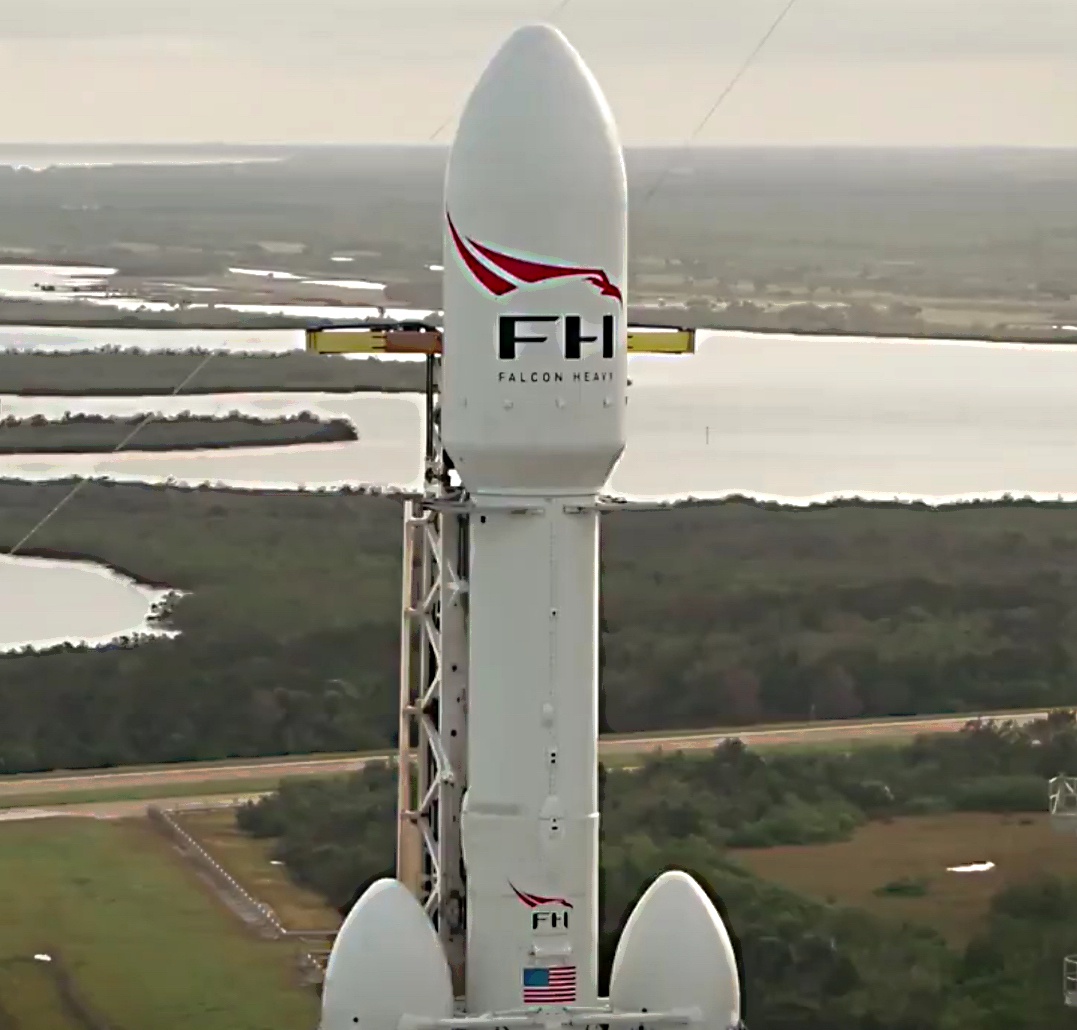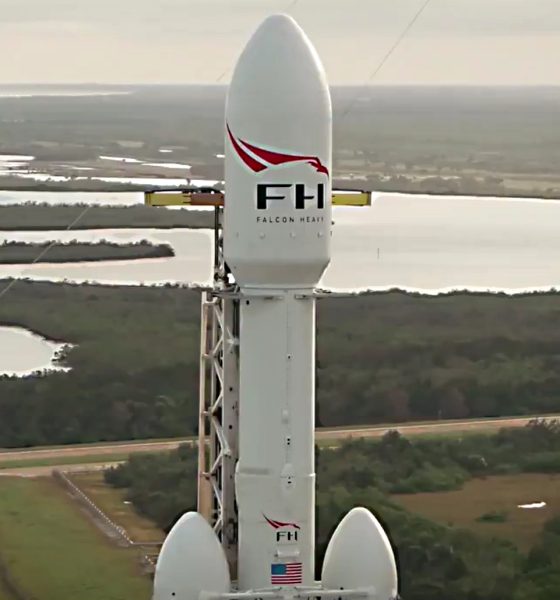

News
SpaceX releases video of world’s most powerful rocket ready for liftoff
Just a few days after its first-ever rollout to Launch Complex 39A, SpaceX has published its official photos of the historic moment, capturing Falcon Heavy poised and ready at the launch pad that could host its inaugural flight as soon as January 15th.
These photos offer the first glimpses of the complete, integrated Falcon Heavy, now with Elon Musk’s Tesla Roadster payload and second stage attached to the massive rocket. While SpaceX has not yet revealed specific details regarding the Roadster’s actual destination, it can be assumed that Falcon Heavy and its second stage will attempt to place it into an extremely stabled orbit around the sun, with one side close to the orbit of Mars. In this configuration, it’s unlikely that there will be any possibility of in-space photo opportunities with the Tesla and Mars. Musk has confirmed that its orbit will be extremely stable, and Roadster will likely remain in its final space journey for hundreds of millions or even billions of years.
With more than 5 million pounds of thrust at liftoff—equal to approximately eighteen 747 aircraft at full power—Falcon Heavy will be the most powerful operational rocket in the world by a factor of two. https://t.co/NneqPRPr46 pic.twitter.com/oswCUreG6i
— SpaceX (@SpaceX) January 3, 2018
While Falcon Heavy’s inaugural launch will apparently see the vehicle operating at only 92% thrust, this performance would still easily catapult the rocket above all other operational launches vehicles by nearly a factor of two.
At a total of 5 million pounds of thrust (22.8 kN), the rocket would be able to lift a fully-fueled 747 passenger jet into low Earth orbit (LEO) in an expendable configuration. Its performance with full recovery of its three first stages is not public, on the other hand, but SpaceX will nevertheless be attempting to recover all first stages alongside the inaugural launch. Approximately 30 seconds before Falcon 9’s usual main engine cut-off (MECO) point, Falcon Heavy’s twin side boosters will separate from the center core (essentially a complete Falcon 9) with the help of some form of mechanical actuators designed to gently push those boosters away from the center.
Quite frankly, the intense aerodynamic forces present at the point of side booster separation mean that it is entirely possible that they may not survive, and could even be drawn back in to impact the center core, an eventuality that would likely bring the mission to a premature end. Typically, rockets with a similar triple booster first stage (Titan IV, Delta IV Heavy) have used relatively powerful separation rockets to more sternly force the side boosters away from the main stage, generally with great success. However, the sort of single-use separation motors would run counter to SpaceX’s primary pursuit of completely reusable rockets.
Risks aside, if all goes well, the side cores will separate and return to the land-based Landing Zone-1 (LZ-1) at Cape Canaveral Air Force Station, and will likely land simultaneously and offer nearby Floridans a double dose of sonic booms as they slow down from speeds well above Mach 3. Meanwhile, the center stage will throttle up and continue on as if it were a Falcon 9. The core stage will finally separate from the second stage and Roadster payload and power back down to Earth to attempt a recovery aboard the drone ship Of Course I Still Love You. Given SpaceX’s previous history of rather exceptional live coverage of both their Falcon 9 launches and landings, fans can expect a truly stunning tour-de-force of a show if the launch goes as planned.
Even then, a failure would still be quite a spectacle and is undeniably a real possibility for any new form or iteration of a rocket. However, it is rather implausible that SpaceX would choose to take unreasonable risks with one of its invaluable launch pads, particularly LC-39A – tasked with supporting SpaceX’s upcoming Commercial Crew demonstration missions no earlier than August 2018. Musk’s hyperbole aside, he can be taken at his word when he in the past commented that the launch would be a spectacle one way or another. The massive vehicle’s first static fire attempt, the final step ahead of launch, is to occur no earlier than January 6th, 2018.
Follow along on Instagram as Teslarati’s launch photographer and correspondent Tom Cross provides behind-the-scenes live coverage of both the launch of Zuma (NET January 5) and the final operations ahead of Falcon Heavy’s first launch.

Elon Musk
Elon Musk’s X will start using a Tesla-like software update strategy
The initiative seems designed to accelerate updates to the social media platform, while maintaining maximum transparency.

Elon Musk’s social media platform X will adopt a Tesla-esque approach to software updates for its algorithm.
The initiative seems designed to accelerate updates to the social media platform, while maintaining maximum transparency.
X’s updates to its updates
As per Musk in a post on X, the social media company will be making a new algorithm to determine what organic and advertising posts are recommended to users. These updates would then be repeated every four weeks.
“We will make the new 𝕏 algorithm, including all code used to determine what organic and advertising posts are recommended to users, open source in 7 days. This will be repeated every 4 weeks, with comprehensive developer notes, to help you understand what changed,” Musk wrote in his post.
The initiative somewhat mirrors Tesla’s over-the-air update model, where vehicle software is regularly refined and pushed to users with detailed release notes. This should allow users to better understand the details of X’s every update and foster a healthy feedback loop for the social media platform.
xAI and X
X, formerly Twitter, has been acquired by Elon Musk’s artificial intelligence startup, xAI last year. Since then, xAI has seen a rapid rise in valuation. Following the company’s the company’s upsized $20 billion Series E funding round, estimates now suggest that xAI is worth tens about $230 to $235 billion. That’s several times larger than Tesla when Elon Musk received his controversial 2018 CEO Performance Award.
As per xAI, the Series E funding round attracted a diverse group of investors, including Valor Equity Partners, Stepstone Group, Fidelity Management & Research Company, Qatar Investment Authority, MGX, and Baron Capital Group, among others. Strategic partners NVIDIA and Cisco Investments also continued support for building the world’s largest GPU clusters.
News
Tesla FSD Supervised wins MotorTrend’s Best Driver Assistance Award
The decision marks a notable reversal for the publication from prior years, with judges citing major real-world improvements that pushed Tesla’s latest FSD software ahead of every competing ADAS system.

Tesla’s Full Self-Driving (Supervised) system has been named the best driver-assistance technology on the market, earning top honors at the 2026 MotorTrend Best Tech Awards.
The decision marks a notable reversal for the publication from prior years, with judges citing major real-world improvements that pushed Tesla’s latest FSD software ahead of every competing ADAS system. And it wasn’t even close.
MotorTrend reverses course
MotorTrend awarded Tesla FSD (Supervised) its 2026 Best Tech Driver Assistance title after extensive testing of the latest v14 software. The publication acknowledged that it had previously criticized earlier versions of FSD for erratic behavior and near-miss incidents, ultimately favoring rivals such as GM’s Super Cruise in earlier evaluations.
According to MotorTrend, the newest iteration of FSD resolved many of those shortcomings. Testers said v14 showed far smoother behavior in complex urban scenarios, including unprotected left turns, traffic circles, emergency vehicles, and dense city streets. While the system still requires constant driver supervision, judges concluded that no other advanced driver-assistance system currently matches its breadth of capability.
Unlike rival systems that rely on combinations of cameras, radar, lidar, and mapped highways, Tesla’s FSD operates using a camera-only approach and is capable of driving on city streets, rural roads, and freeways. MotorTrend stated that pure utility, the ability to handle nearly all road types, ultimately separated FSD from competitors like Ford BlueCruise, GM Super Cruise, and BMW’s Highway Assistant.
High cost and high capability
MotorTrend also addressed FSD’s pricing, which remains significantly higher than rival systems. Tesla currently charges $8,000 for a one-time purchase or $99 per month for a subscription, compared with far lower upfront and subscription costs from other automakers. The publication noted that the premium is justified given FSD’s unmatched scope and continuous software evolution.
Safety remained a central focus of the evaluation. While testers reported collision-free operation over thousands of miles, they noted ongoing concerns around FSD’s configurable driving modes, including options that allow aggressive driving and speeds beyond posted limits. MotorTrend emphasized that, like all Level 2 systems, FSD still depends on a fully attentive human driver at all times.
Despite those caveats, the publication concluded that Tesla’s rapid software progress fundamentally reshaped the competitive landscape. For drivers seeking the most capable hands-on driver-assistance system available today, MotorTrend concluded Tesla FSD (Supervised) now stands alone at the top.
News
Elon Musk’s Grokipedia surges to 5.6M articles, almost 79% of English Wikipedia
The explosive growth marks a major milestone for the AI-powered online encyclopedia, which was launched by Elon Musk’s xAI just months ago.

Elon Musk’s Grokipedia has grown to an impressive 5,615,201 articles as of today, closing in on 79% of the English Wikipedia’s current total of 7,119,376 articles.
The explosive growth marks a major milestone for the AI-powered online encyclopedia, which was launched by Elon Musk’s xAI just months ago. Needless to say, it would only be a matter of time before Grokipedia exceeds English Wikipedia in sheer volume.
Grokipedia’s rapid growth
xAI’s vision for Grokipedia emphasizes neutrality, while Grok’s reasoning capabilities allow for fast drafting and fact-checking. When Elon Musk announced the initiative in late September 2025, he noted that Grokipedia would be an improvement to Wikipedia because it would be designed to avoid bias.
At the time, Musk noted that Grokipedia “is a necessary step towards the xAI goal of understanding the Universe.”
Grokipedia was launched in late October, and while xAI was careful to list it only as Version 0.1 at the time, the online encyclopedia immediately earned praise. Wikipedia co-founder Larry Sanger highlighted the project’s innovative approach, noting how it leverages AI to fill knowledge gaps and enable rapid updates. Netizens also observed how Grokipedia tends to present articles in a more objective manner compared to Wikipedia, which is edited by humans.
Elon Musk’s ambitious plans
With 5,615,201 total articles, Grokipedia has now grown to almost 79% of English Wikipedia’s article base. This is incredibly quick, though Grokipedia remains text-only for now. xAI, for its part, has now updated the online encyclopedia’s iteration to v0.2.
Elon Musk has shared bold ideas for Grokipedia, including sending a record of the entire knowledge base to space as part of xAI’s mission to preserve and expand human understanding. At some point, Musk stated that Grokipedia will be renamed to Encyclopedia Galactica, and it will be sent to the cosmos.
“When Grokipedia is good enough (long way to go), we will change the name to Encyclopedia Galactica. It will be an open source distillation of all knowledge, including audio, images and video. Join xAI to help build the sci-fi version of the Library of Alexandria!” Musk wrote, adding in a later post that “Copies will be etched in stone and sent to the Moon, Mars and beyond. This time, it will not be lost.”








